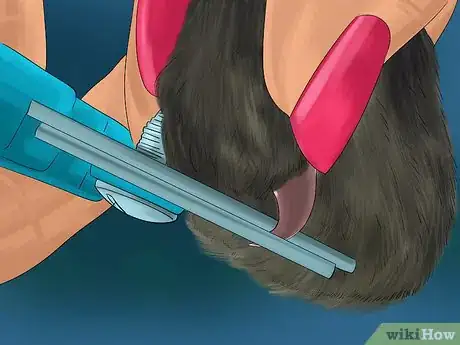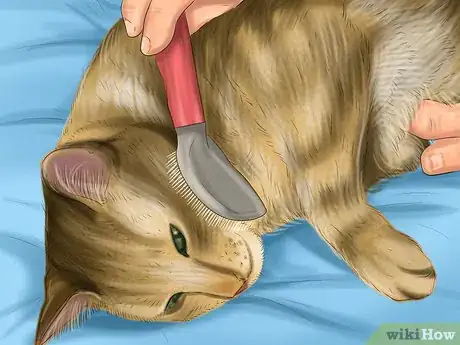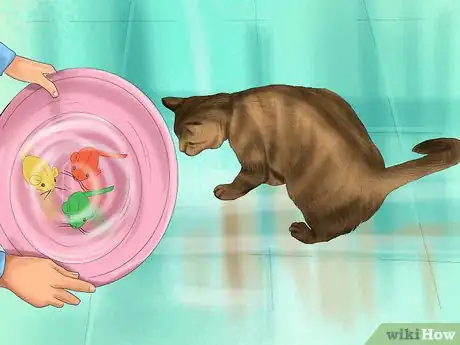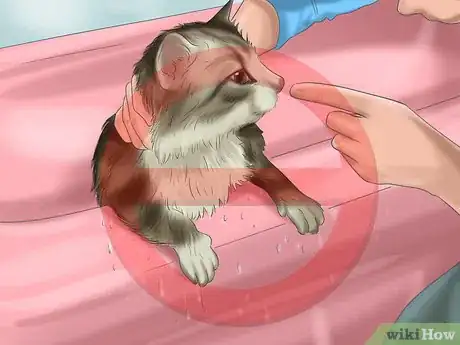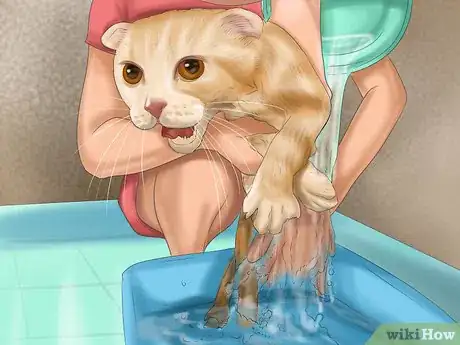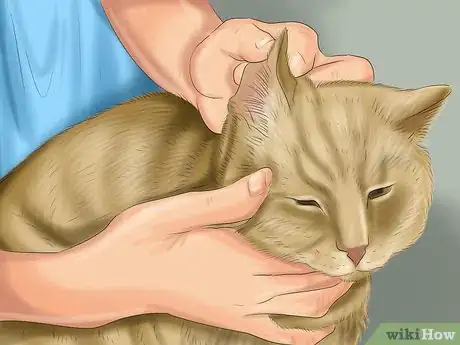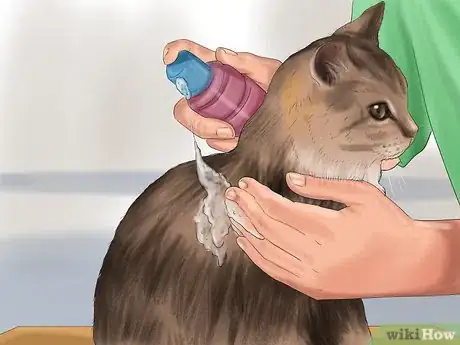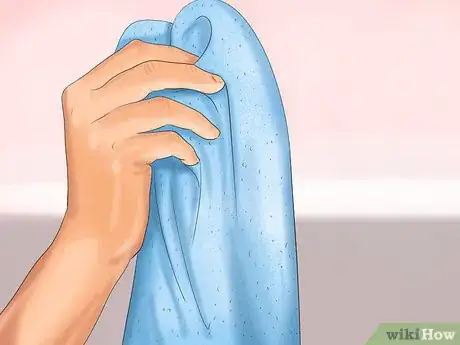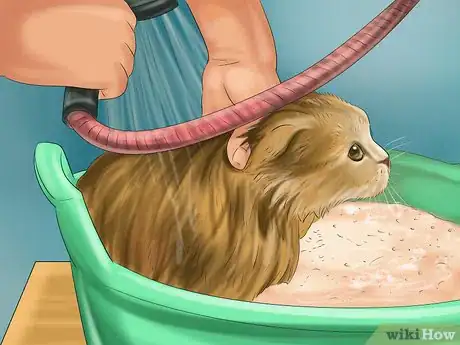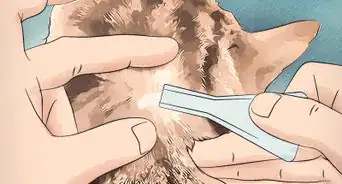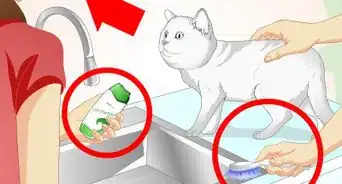This article was co-authored by Brian Bourquin, DVM. Brian Bourquin, better known as “Dr. B” to his clients, is a Veterinarian and the Owner of Boston Veterinary Clinic, a pet health care and veterinary clinic with three locations, South End/Bay Village, the Seaport, and Brookline, Massachusetts. Boston Veterinary Clinic specializes in primary veterinary care, including wellness and preventative care, sick and emergency care, soft-tissue surgery, dentistry. The clinic also provides specialty services in behavior, nutrition, and alternative pain management therapies using acupuncture, and therapeutic laser treatments. Boston Veterinary Clinic is an AAHA (American Animal Hospital Association) accredited hospital and Boston’s first Fear Free Certified Clinic. Brian has over 19 years of veterinary experience and earned his Doctor of Veterinary Medicine from Cornell University.
wikiHow marks an article as reader-approved once it receives enough positive feedback. This article received 22 testimonials and 87% of readers who voted found it helpful, earning it our reader-approved status.
This article has been viewed 2,833,469 times.
While cats can be meticulous groomers, there are times when they really need a bath. Sometimes they get into something very sticky or dirty. Other times, they have a medical condition that requires regular bathing with medicated shampoo. Despite this, most cats will react negatively to getting a bath, which can be stressful for both the cat and the owner. Luckily, there are a few things you can do to make bath time less stressful for both parties, and this wikiHow will show you how.
Steps
Getting Your Cat Ready for a Bath
-
1Trim your cat's claws. Your cat may become excited or scared when covered in water, so to decrease the damage they may cause, trim their nails before you give them a bath. Try to do this a few hours or even a day or two before the bath so they have time to calm down bathing.[1] Take care to cut at a point which will not cause pain or bleeding.
- Giving your kitty treats as a reward for getting their nails trimmed will always make them feel better and calmer.
-
2Brush your cat. Do not skip this step. Brushing the cat will help remove any knots and tangles in the fur, which will be much more difficult and painful to remove once your cat is wet. If your kitty likes getting brushed, then you can use the brush to make the kitty feel more at home in the tub.[2]
- Sometimes you can even brush your cat as a way to distract them enough to allow their nails to be trimmed. This is a great way of killing two birds with one stone, but you'll need another person to help you.
Advertisement -
3Get the right cat shampoo. You can get kitty shampoo from your vet or local pet store. Check the instructions to see if it's right for your cat, and dilute it with water if necessary. Using regular human shampoo can not only dry out your cat's skin but can be toxic for your cat. Don't use dog shampoo in a pinch, either. You're better off using water rather than a product that can harm your cat.
- You may want a washcloth for massaging the shampoo onto your cat's body, but your hands may actually be better for this.
-
4Make your cat want to bathe. The first thing you should do is tire your kitty out, so they are at their most mellow before they enter the water. This will make them less likely to bite, scratch, or to try to get away. Pick a time when your kitty is at their calmest — often after they have been fed. If they still act hyper, play with them as much as you can until they are worn out. Here are some other ways to get your kitty adjusted to the bath before you start bathing them:
- Put some cat toys in the empty tub. Place your cat in it and play for a few minutes. Then stop and add a little water before playing again. By doing so, you'll get your cat used to the tub and water. Bath time will soon be associated with something pleasant and non-threatening.
- You could also have a special toy just for bath time, such as a mouse on a string or something that floats. Only allow your cat to play with this toy in the tub and it will inspire him to look forward to bathing, instead of fearing it.
Preparing the Bathroom
-
1Close the bathroom door. This will keep your cat from escaping and, if you have more than one cat, will keep the others out. A yowling cat can frighten your bathing cat, making it likely to scratch or panic. Keeping the door closed will also prevent your cat from running out and tearing things up out of fear.
- If your cat has never been in the bathroom before, you might want to get him used to the area. Also, if the bathroom has a toilet, keep the toilet seat down at all times. Your cat might jump into the toilet in a complete panic!
- Likewise, if you have a litter box in the same room as you are bathing the cat, remove it. If your cat escapes from the bath, it may make a beeline to the litter box and make a huge mess.
-
2Make the tub secure. Lay down a rubber mat or towel in the tub so your kitty doesn't slip and has more comfortable footing. You'll need to place some towels on the floor because it'll get wet. Also, have at least two towels on hand for drying kitty when the time comes.
- You can also place a small cooling rack or oven rack in the tub to give the cat something to hold on to. This reduces the chance of you being scratched and makes the cat feel more secure.
-
3Set up the tubs. Fill the tub with a few inches of warm, not hot, water before bringing your cat into the bathroom, since some cats can be unnerved by running water. Fill two large cups or, ideally, plant watering pots, which allow you to direct the flow of water as you rinse the cat. This is so you don't need to run more water during the bath, which might frighten your cat.[3]
- Do not use the overhead shower head or faucet to bathe your kitty. This will make the water pour down too hard and can overwhelm your cat. The bath should be as gentle and soothing as possible and shouldn't feel like a water attack.
- You won't have time to run out for anything while your cat is in the bath, so you'll need to have everything ready. Be prepared and calm.
-
4Wear protective clothing. This will keep you safe from any possible scratches, minor or major. A jumper, sweater, or long-sleeved shirt should be worn so that your cat has no bare skin to scratch. You can wear long-sleeved gloves, but these are bulky and can get in the way. Be careful and gentle when you rub his head and belly, since these are sensitive areas.
- It is also a good idea to wear clothing that isn't new and that you don't mind getting wet.
Bathing Your Cat
-
1Maintain control of your cat. Talk to your cat in a calm, quiet voice while washing. Sometimes cats will try to get out of the tub. If they prefer to have only two of their feet in the water, face them toward the back of the tub and let them stand on two feet. Do your best to hold them still.
- Using a well-fitting harness is recommended to safely hold your cat in the bathtub. A harness allows you to hold them in the bath tub by holding onto the harness instead of the scruff their neck or collar, which could hurt your cat.
- It's easier to bathe your cat if there are two people involved, especially if your cat is rather strong and can kick and wriggle its way out of your hands. One person can restrain by the scruff and the other bathes the cat. You should plan to be done as quickly as possible without rushing. Be sure your cat can breathe comfortably while restrained.
-
2Avoid fighting your cat. At no point is it recommended to fight with your cat. A scared 10 pound cat can do a lot of damage to a human (or two). You may need to start with just getting the feet and legs wet and then stop. Try more another day and work your way up to a full bath.
- If you're nervous or excited about the process, your kitty will know and respond by being nervous too.
-
3Soak your kitty from the neck down. Use a little bit of shampoo and water to wash your cat's neck, body, legs, belly, and tail. Start at the neck and work toward their tail, in the direction of the growth of their fur. Wash the cat in a massaging motion, so they feel soothed, not scared. Act like you're just petting and grooming your cat and that this trip to the bathtub is nothing special.
-
4Keep shampoo out of your cats eyes, nose, mouth, and ears. To minimize the risk of creating an ear infection, put a cotton ball—a small wad of soft material used to stop up a wound or an opening—in each ear. Don't forget to take them out at the end of the bath. The cotton may also reduce the noise and make your job easier.
- If you are giving your cat a flea bath, wet the area around its neck first. Fleas will try to escape to the dry areas of the cat, which can mean a mass exodus of fleas to the head and face while you are bathing. A wet neck will keep them off the head, and in contact with the water and flea shampoo.
-
5Rinse the shampoo from your kitty. Rinse your kitty thoroughly using the water in the tub. Then, drain the tub and rinse two more times with water from the bucket or warm water from the tap. It is essential that you remove all the soap from the coat. Keep rinsing until the water is completely clear and shows no sign of bubbles or soap.
- Diluting your shampoo before you get started will help prevent using too much soap or detergent that will need extra rinsing later.
- If your cat has a long, thick coat, this process will take even longer.
-
6Wash your kitty's face with water and a washcloth. There's no need to take the risk of upsetting and hurting your cat by getting shampoo or soap in their eyes. Take a wet washcloth and gently run it along your kitty's face, brushing the fur away from their eyes and nose, until their face, head, and ears are nice and clean.[4]
- You may want to consider leaving this for another time and call it quits after getting the bath done unsuccessfully.
- Don't ever force your cat's face under water. This is guaranteed to make them panic.
-
7Watch your cat for signs of panic and distress. These sounds include: hissing, growling, breathing hard, sneezing, crying, and meowing. Pay attention to your cat throughout bath time. If your cat is too frightened by anything you are doing, stop. There is no reason to continue if one or both of you will get hurt or the cat is extraordinarily stressed.
- Be easy on your cat for his first bath. Don't do anything that will greatly upset them and make him dread the next bath. It's better to take things slowly so you can try again next time.
-
8Use a wet washcloth, if your cat really protests being bathed. It removes the outer dirt and cleans well. You can find treated cloths at pet stores that need no water to groom the cat. They even have a pleasant scent.
- Instead of a washcloth, you can also use a sprayer to clean your cat rather than dunking it into a bath.[5]
Drying Your Cat
-
1Blot the water from your cat. Take a towel and gently press as much water as you can from the fur. Then, wrap your cat in the towel and rub gently. When the towel gets too wet to be effective, switch to another dry towel. Don't stop until only the towel(s) are only wet.[6]
- When you blot the water from your kitty, do it in a gentle motion, as if you're massaging them. Also consider warming the towels in the dryer first, as many cats find this comforting.
- Again, work with your cat. If they won't allow you to keep drying with the towels, respect that and stop.
-
2Finish drying your cat. Short-haired cats can finish drying themselves in the bathroom as long as they're away from drafts. They will appreciate a heat source (space heater or warm air vent) and a dry towel to sit on. With long-haired cats, you will have to use a comb and more towels. Long hairs mat more easily when wet, so you might want to comb the coat until it is completely dry.
- If your cat is not scared of a hair dryer, you can use a dryer set on warm, not hot, to finish drying your cat from a distance. Avoid using a hot blow dryer on any cat as it may burn them and cause more trauma.
- You can also gently brush your kitty's fur to get rid of any knots or tangles. This can be especially helpful for a long-haired cat.
-
3Reward your cat. This is a must. If you want your cat to ever want to take a bath again, you must give them a positive association with the process. Give their favorite wet food, catnip, or other treats. You can even give him an even more indulgent treat that you save for exceptionally rare occasions. If they associate bathing with receiving delicious treats, your cat will be clamoring for another go in the bathtub in no time at all.[7]
- You should also praise your kitty by petting them, telling them what a good kitty they are, and giving lots of attention when the bath is over. They are likely to feel vulnerable and scared if not loved, so your affection will make a big difference.
Using Alternative Methods for Bathing Your Cat
-
1Bathe your cat by using small buckets of water. Make separate bathing stations using two buckets. Fill the buckets half-full with warm water. Dip the cat in a bucket and, using a washcloth, make sure the cat is entirely wet. Then, massage a small amount of cat shampoo throughout their fur. Put the cat in the other bucket to rinse until soap is gone.
- You may need a second rinse bucket with clean water to make sure that all the soap is gone from your kitty’s coat.
- This technique can be done outside if the weather is warm and sunny. Two people will be needed, since your cat will most likely try to escape. This technique is not recommended for indoor-only cats who are not used to being outside.
-
2Bathe your cat in the shower. Make sure the cat has good traction, such as a small towel or rubber mat in the tub, and that the shower has a closing door, not a curtain, to prevent the cat from escaping. Make sure you have a long hose to wet your cat completely, then lather him up, hose him down to rinse, and then proceed with drying. Use a gentle stream of water and keep the pressure low.
- Note that some cats seem to love being in the shower and may not mind this approach, but many cats find the sound of running water frightening. This technique may result in someone getting injured, including the cat.
- You can buy a hose adapter for your bathroom sink and a hose long enough to reach over the shower door and back down to the shower floor. Or get a hand-held spray shower and a Y-adapter to connect to your regular shower head.
-
3Bathe your small kitty in a sink or small tub. Some kitties feel more secure in an enclosed space and can also be easier to control. If you have a small or scared cat, try bathing him in the sink or in a smaller tub within your bathtub. Simply place a large plastic container in the bottom of your bathtub. You can still fill the small tub or sink with a few inches of water, shampoo the kitty, and proceed as usual. Please be sure that the sink that you use does not have a garbage disposal, for even if it is turned off, paws can easily slip through the drain and be hurt by the blades, below.
- This can work with a larger kitty who likes small spaces, too.
- Put a terrycloth towel in the bottom of your tub, so your cat can feel secure by sinking their claws into something that remains steady. You can also apply light to medium pressure to your cat's back and use a calming tone to relieve anxiety.
-
4Give your cat a dry bath. If your cat is very oily, consider using cornstarch instead of water to bathe him. Dust your cat with cornstarch and gently pet the cat to thoroughly rub the cornstarch into its fur. Let the cornstarch sit for about twenty minutes and then brush it out.
- This technique is far less traumatic than using water, but should not be used to wash off anything poisonous that your cat has gotten onto his fur.
Expert Q&A
Did you know you can get expert answers for this article?
Unlock expert answers by supporting wikiHow
-
QuestionHow do I wash my cat without getting scratched?
 Brian Bourquin, DVMBrian Bourquin, better known as “Dr. B” to his clients, is a Veterinarian and the Owner of Boston Veterinary Clinic, a pet health care and veterinary clinic with three locations, South End/Bay Village, the Seaport, and Brookline, Massachusetts. Boston Veterinary Clinic specializes in primary veterinary care, including wellness and preventative care, sick and emergency care, soft-tissue surgery, dentistry. The clinic also provides specialty services in behavior, nutrition, and alternative pain management therapies using acupuncture, and therapeutic laser treatments. Boston Veterinary Clinic is an AAHA (American Animal Hospital Association) accredited hospital and Boston’s first Fear Free Certified Clinic. Brian has over 19 years of veterinary experience and earned his Doctor of Veterinary Medicine from Cornell University.
Brian Bourquin, DVMBrian Bourquin, better known as “Dr. B” to his clients, is a Veterinarian and the Owner of Boston Veterinary Clinic, a pet health care and veterinary clinic with three locations, South End/Bay Village, the Seaport, and Brookline, Massachusetts. Boston Veterinary Clinic specializes in primary veterinary care, including wellness and preventative care, sick and emergency care, soft-tissue surgery, dentistry. The clinic also provides specialty services in behavior, nutrition, and alternative pain management therapies using acupuncture, and therapeutic laser treatments. Boston Veterinary Clinic is an AAHA (American Animal Hospital Association) accredited hospital and Boston’s first Fear Free Certified Clinic. Brian has over 19 years of veterinary experience and earned his Doctor of Veterinary Medicine from Cornell University.
Veterinarian
-
QuestionWhat if my cat hates baths?
 Brian Bourquin, DVMBrian Bourquin, better known as “Dr. B” to his clients, is a Veterinarian and the Owner of Boston Veterinary Clinic, a pet health care and veterinary clinic with three locations, South End/Bay Village, the Seaport, and Brookline, Massachusetts. Boston Veterinary Clinic specializes in primary veterinary care, including wellness and preventative care, sick and emergency care, soft-tissue surgery, dentistry. The clinic also provides specialty services in behavior, nutrition, and alternative pain management therapies using acupuncture, and therapeutic laser treatments. Boston Veterinary Clinic is an AAHA (American Animal Hospital Association) accredited hospital and Boston’s first Fear Free Certified Clinic. Brian has over 19 years of veterinary experience and earned his Doctor of Veterinary Medicine from Cornell University.
Brian Bourquin, DVMBrian Bourquin, better known as “Dr. B” to his clients, is a Veterinarian and the Owner of Boston Veterinary Clinic, a pet health care and veterinary clinic with three locations, South End/Bay Village, the Seaport, and Brookline, Massachusetts. Boston Veterinary Clinic specializes in primary veterinary care, including wellness and preventative care, sick and emergency care, soft-tissue surgery, dentistry. The clinic also provides specialty services in behavior, nutrition, and alternative pain management therapies using acupuncture, and therapeutic laser treatments. Boston Veterinary Clinic is an AAHA (American Animal Hospital Association) accredited hospital and Boston’s first Fear Free Certified Clinic. Brian has over 19 years of veterinary experience and earned his Doctor of Veterinary Medicine from Cornell University.
Veterinarian
-
QuestionWhat can I use as shampoo for my cat?
 Pippa Elliott, MRCVSDr. Elliott, BVMS, MRCVS is a veterinarian with over 30 years of experience in veterinary surgery and companion animal practice. She graduated from the University of Glasgow in 1987 with a degree in veterinary medicine and surgery. She has worked at the same animal clinic in her hometown for over 20 years.
Pippa Elliott, MRCVSDr. Elliott, BVMS, MRCVS is a veterinarian with over 30 years of experience in veterinary surgery and companion animal practice. She graduated from the University of Glasgow in 1987 with a degree in veterinary medicine and surgery. She has worked at the same animal clinic in her hometown for over 20 years.
Veterinarian
Warnings
- If you don't know how to properly hold a cat by the scruff, don't do it. Your cat may choke.⧼thumbs_response⧽
- Do not bathe your pet any more than once every two weeks. Excessive bathing may remove protective oils from its fur, making it appear dull, and reducing the fur's natural efficiency against the elements.⧼thumbs_response⧽
- Very young, very old or very thin cats do not regulate their own temperatures well. Make sure to dry the cat completely and keep them warm to avoid hypothermia (low body temperature).⧼thumbs_response⧽
- Make sure the outside air temperature is over 70° F (21 °C) and at low humidity. Keep a cat indoors and warm for 12 hours after a bath if the weather won't cooperate.⧼thumbs_response⧽
Things You'll Need
- Shampoo, safe for a cat
- Conditioner (optional)
- Two or more bath towels
- Brush/comb
- A bath
- Warm water (not lukewarm, but almost hot!)
- A long sleeved shirt, sweatshirt, or long gloves
- Two or more people
- Treats
- A toy (optional)
- A bathroom with the door closed
References
- ↑ http://www.aspca.org/pet-care/cat-care/bathing-your-cat
- ↑ http://www.aspca.org/pet-care/cat-care/bathing-your-cat
- ↑ http://www.aspca.org/pet-care/cat-care/bathing-your-cat
- ↑ http://www.aspca.org/pet-care/cat-care/bathing-your-cat
- ↑ Brian Bourquin, DVM. Cat Behavior Trainer. Expert Interview. 20 December 2019.
- ↑ http://www.catster.com/lifestyle/bathe-cat-care-without-bloodshed
- ↑ http://www.catster.com/lifestyle/bathe-cat-care-without-bloodshed
About This Article
To bathe your cat, start by brushing it to get rid of any knots and tangles, which will be easier to get out before your cat is wet. Next, bring your cat into the bathroom and close the bathroom door in case your cat tries to escape. Then, fill up the tub with a few inches of warm water and place your cat inside of it. Wash your cat from the neck down with cat shampoo and water, and try not to get any shampoo in your cat's eyes, nose, mouth, or ears. When you're finished, wrap a towel around your cat and rub gently to dry it off. To learn alternative ways you can bathe your cat if it really hates water, scroll down!
